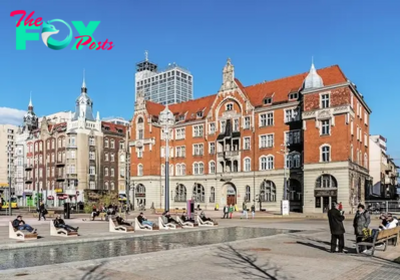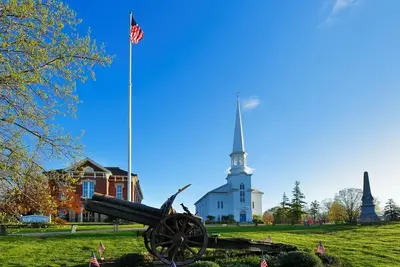Travel
15 Best Things to Do in Concord (MA)
Revolutionary and literary history converge at this captivating town where the “shot heard ‘round the world” was fired on April 19, 1775, when the first British troops died at the hands of the American colonial militia.
Ralph Waldo Emerson (1803-1882), the famed Transcendentalist who coined that phrase, spent most of his adult life in Concord, and was a mentor to some of American history’s great writers and thinkers.
From the mid-19th century, Concord would be a hotbed of ideas and creativity, where the likes of Louisa May Alcott (1832-1888), Henry David Thoreau (1817-1862), and Nathaniel Hawthorne (1804-1864) were all active.
You’ll need multiple days in Concord to squeeze in the many sites of resounding importance, artifact-laden museums and lovingly preserved historic houses, all with the power to fascinate and move anybody today.
1. Minute Man National Historical Park
 Source: Alexey Stiop / shutterstock
Source: Alexey Stiop / shutterstockIn Concord, Lexington and Lincoln you can see exactly where the American Revolution officially broke out.
At sites like the the Old North Bridge, where the first British lives were claimed, and the Lexington Battle Green, where the first American militia fell, you can relive the world-changing events of April 19, 1775.
For a great primer, the park’s main Visitor Center is a few minutes from Concord in Lincoln, and sets the scene with the 25-minute Road to Revolution multimedia presentation.
Also not to be missed is the Hartwell Tavern, a restored 18th-century inn, with park rangers dressed in period costume.
2. The Old North Bridge
 Source: Christian Delbert / shutterstock
Source: Christian Delbert / shutterstockOne unit of the National Historical Park contains the place where, on April 19, 1775 American forces first inflicted casualties on British troops.
At this crossing, some 400 militia and minutemen engaged and routed 90 British army troops. Three British soldiers were killed in this fight, two of which were buried close to the bridge, on the edge of the Old Manse property a few steps away.
Ralph Waldo Emerson later described this event and its significance as the “shot heard ‘round the world.”
The bridge itself is the latest in a long line of wooden crossings at this point on the Concord River.
The current design, dating to 1956 and restored in 2005, is based on contemporary accounts. Close by stands the The Minute Man (1874) sculpture by David Chester French, cast in bronze from ten Civil War cannons.
3. Louisa May Alcott’s Orchard House
 Source: Keith J Finks / shutterstock
Source: Keith J Finks / shutterstockThe house where Louisa May Alcott wrote and set Little Women (1868-69), is open to the public seven days a week, all year round as an historic house museum.
This clapboard Colonial farmhouse is from the turn of the 18th century, and was accompanied by a 12-acre apple orchard when the Alcotts moved here in 1858.
The family, composed of Bronson, his wife Abigail May, and daughters Anna, Louisa, and May, lived here until 1877. Elizabeth, the inspiration for Beth March, had passed away just before the family moved in.
The house looks as it did when the Alcotts were in residence, and most of the furnishings are from the 19th century and belonged to the family.
A visit is a bit like spending time in the book: On the walls are portraits and watercolors by May, while in the kitchen is a soapstone sink purchased by Louisa, and a drying rack designed by Bronson, known for being handy and building the shelf desk at which Louisa wrote Little Women.
4. Battle Road Trail
 Source: Monika Salvan / shutterstock
Source: Monika Salvan / shutterstockAt the Minute Man Visitor Center you can pick up a map to retrace the route of the initial retreat by the British regulars, and the running battles between them and thousands of Colonial militia.
Often preserving the original vestiges of the Battle Road, the trail runs for five miles from Meriam’s corner to the eastern edge of the national park in Lexington.
You’ll be traveling through a Colonial landscape steeped in history, over gently rolling hills with forest, wetlands and open fields.
Some sights to check out on the Concord stretch are the British graves at Meriam’s Corner, and several residences that were already here when the fighting broke out.
These include the Nathan Meriam House (c. 1705), the Farwell Jones House (c. 1716), the Stow-Hardy House (c. 1689) and the Samuel Brooks House (1692).
5. Concord Museum
 Source: Wangkun Jia / shutterstock
Source: Wangkun Jia / shutterstockYou can be sure that the town museum for a place like Concord will have some amazing collections, spanning both its Revolutionary History and its many literary figures.
The Concord Museum does not disappoint, with the largest single collection for Henry David Thoreau, including furniture from the cabin at Walden Pond, where he wrote A Week on the Concord and Merrimack Rivers (1849) and began to develop his most famous work, Walden (1854).
You can peruse Ralph Waldo Emerson’s study, re-created as it was at his death in 1882, as well as the lantern in Henry Wadsworth Longfellow’s poem “Paul Revere’s Ride” (1860).
There are cannoNBAlls, muskets, fifes and powder horns from the American Revolution, along with a fine inventory of 17th, 18th and 19th-century decorative arts, displayed in period settings and including furniture, clocks, ceramics, textiles, metalware, looking glasses and more.
6. North Bridge Visitor Center
 Source: Wangkun Jia / shutterstock
Source: Wangkun Jia / shutterstockFittingly, the National Historical Park’s North Bridge Visitor Center is in a mansion built by descendents of Major John Buttrick, the officer who first ordered his militia to fire upon British troops.
For some background, there’s an eight-minute film here outlining the events that led to a fight with momentous repercussions.
One thrilling exhibit is The Hancock, one of four brass cannons smuggled out of Boston, the recovery of which was one of General Gage’s main reasons for sending British regulars to Concord on April 19, 1775.
The mansion is a short but very scenic walk from the bridge, and is accompanied by delightful formal gardens that are open to the public.
7. The Old Manse
 Source: Wangkun Jia / shutterstock
Source: Wangkun Jia / shutterstockBy the Concord River, overlooking the North Bridge, is a Georgian house from 1770, with volumes of engrossing history, even by Concord’s standards.
The Old Manse is maintained by the Trustees of Reservations and was built for the grandfather of Ralph Waldo Emerson. The writer lived here in his 20s and 30s, during which time he wrote the first draft of Nature (1836) and proposed to Lidian Jackson.
Later Nathaniel Hawthorne, resided here with his wife Sophia Peabody as newlyweds for a few productive years in the 1840s, composing around 20 sketches and tales during his stay.
Just before they arrived, Henry David Thoreau planted a vegetable garden for the couple on the property as a wedding gift.
Structurally, the house has hardly changed in more than 250 years, and has room after room filled with memorabilia relating to some of America’s most esteemed minds.
Especially touching are the little poems etched for one another in the window panes by the Hawthornes some 180 years ago.
8. Walden Pond State Reservation
 Source: James Kirkikis / shutterstock
Source: James Kirkikis / shutterstockStarting in 1845, Henry David Thoreau spent two years living in a single-room cabin on the northern shore of this pond.
This stay would later form the basis for his famous book, Walden; or, Life in the Woods (1854), in which he reflected on a simple life in natural surroundings.
These ideas are believed by many to have laid the groundwork for the conservation movement later in the century.
You can feel your own kinship with nature at this 335-acre state park, around that kettle hole pond, formed by retreating glaciers around 10,000 years ago.
Granite posts mark the original location of Thoreau’s cabin, and you can check out a replica, as well as exhibits and a Thoreau Society shop at the visitor center.
The pond is a popular spot for swimming and boating in the summer, with a perimeter trail and picnic areas near the shore.
9. Ralph Waldo Emerson House
 Source: Zack Frank / shutterstock
Source: Zack Frank / shutterstockThe roots of Concord’s decades-long spell as a literary center go back to the return of Ralph Waldo Emerson to the town in 1835 with his wife Lidian, shortly after marrying.
Emerson would remain at this house at 28 Cambridge Turnpike for almost 50 years, the rest of his life. During this time he completed the final draft of his seminal essay Nature in 1836, and Self Reliance in 1841.
Emerson’s speeches and writings attracted other writers and thinkers to Concord, many of whom visited him at this house.
And as well as keeping farm animals, the barn on the property was used as a schoolroom for a time, educating the Emerson children, as well as Lizzy and Abby Alcott, Lizzy and Barry Goodwin, and Caroline Pratt.
The house is open for tours through late October, and is presented as it was following a restoration in the early 1870s.
10. The Wayside
 Source: William Silver / shutterstock
Source: William Silver / shutterstockThought to date back to more than 300 years, at the onset of the Revolution this house was occupied by Samuel Whitney, a member of the Massachusetts Provincial Congress in 1775 and muster-master for Concord’s minutemen.
Right next door to the Orchard House, The Wayside is best known for its rich literary associations, and demands a guided tour for this reason. Louisa May Alcott lived here with her family from her early teens up to the age of 20.
Then the renowned author Nigel Hawthorne moved in, and this would be the only home that he ever owned. In between European trips he resided here from 1852 to until his death in 1864, followed briefly (1879-1881) by poet and novelist George Parsons Lathrop.
For the next 40 years, The Wayside was the home of Harriet Lothrop (pen name Margaret Sidney), a successful children’s author, who lived here with her publisher husband Daniel Lothrop.
11. Thoreau Farm
 Source: Thoreau Farm - Birthplace of Henry David Thoreau / Facebook
Source: Thoreau Farm - Birthplace of Henry David Thoreau / FacebookOn 20 acres on eastern concord stands the house in which Henry David Thoreau was born in 1817. Carefully restored, the Wheeler-Minot Farmhouse is a beautiful Georgian wood frame structure, built around 1730.
The Thoreau connection goes back to Deacon Samuel Minot (1714–1786), who purchased the farm for his son, Jonas, who would become the stepfather of Thoreau’s mother.
A highlight of the guided tour is the second-floor room in which the writer was born. The Thoreau Farm is open on weekends, May through October, and is an apt setting for panel discussions, author talks and writing workshops, in partnership with the Thoreau Society.
12. Sleepy Hollow Cemetery
 Source: Lucas Correa Pacheco / shutterstock
Source: Lucas Correa Pacheco / shutterstockA short walk from Concord’s center you can visit the resting place of almost all of the figures mentioned in this article.
Ralph Waldo Emerson was present to give a speech when Sleepy Hollow Cemetery was dedicated in 1855, and was among the many people who would take evening walks here before this was a place of burial.
The rambling, natural layout is informed by Transcendentalism, as much a place to benefit the living as somewhere to honor the dead.
Among the luminaries laid to rest at the cemetery are Emerson himself, Louisa May Alcott (along with many members of her family), Nathaniel and Sophia Hawthorne, Henry David Thoreau, and poet William Ellery Channing.
These graves can all be found at Authors’ Ridge, while the poignant Art Nouveau Melvin Memorial close by marks the graves of three brothers killed in the Civil War, and was a collaboration between sculptor Daniel Chester French and architect Henry Bacon.
13. The Robbins House
 Source: Rachel Rose Boucher / shutterstock
Source: Rachel Rose Boucher / shutterstockA different aspect of Concord’s intriguing History is revealed at this 1 ½-story residence, built at the beginning of the 19th century.
The Robbins House was home to the first generation descendants of Caesar Robbins, a formerly enslaved veteran of the American Revolutionary War and the French and Indian War (1754-1763).
This dwelling was shared by two families, the other being that of Jack Garrison, also formerly enslaved, and gaining his freedom in New Jersey.
African Americans lived at the Robbins House up to 1870, and during your visit to the North Bridge you can come by (Fri-Sun) for an insight into Concord’s African American story.
14. Great Meadows National Wildlife Refuge
 Source: SciTech Photos / shutterstock
Source: SciTech Photos / shutterstockThe original of the two units for this 12 mile-long wetlands conservation area is in Concord. This comprises a pair of pools along the Concord River, drained in summer to reveal mudflats that are flocked by numerous bird species in the late summer months.
These are nutrient-rich feeding grounds for sandpipers, great egrets, great blue herons, Canada geese and a host of different duck species.
There are almost three miles of trails, as well as an observation platform and an observation tower, at what is believed to be one of the best inland birding sites in Massachusetts.
15. Verrill Farm
 Source: Massachusetts Office of Travel & Tourism / Flickr | CC BY-ND
Source: Massachusetts Office of Travel & Tourism / Flickr | CC BY-NDThis sustainably managed farm in Concord has been in the same family since 1918, while the land has been worked for more than three centuries.
Thanks to methods like tilling, crop rotation and the use of organic matter for fertilizer, the soils at Verrill Farm are as fertile as ever. Starting in June you can visit for PYO strawberries, self-cut sunflowers, PYO sweetcorn, and there’s a pumpkin patch infall.
There’s a host of events throughout this time, including Family Farm Day in September, and the Annual Harvest Festival in October, with live music, hayrides, farm Animals and Games.
In front of the fields, the farm stand and greenhouse are open seven days a week all year, selling homegrown fresh produce, deli items, freshly baked, pies, flowers & plants, and much more.
-

 Travel16h ago
Travel16h agoAn Oasis in Bucharest: A Day at Therme Spa
-

 Travel21h ago
Travel21h agoBhagyashree calls her visit to Kashmir ‘Jannat ke Darshan’
-

 Travel22h ago
Travel22h agoBran Castle: A Scenic Train Ride to Romania’s Legendary Castle
-

 Travel22h ago
Travel22h ago17 Best Things to do in Katowice, Poland
-

 Travel1d ago
Travel1d agoExplore Germany and South Korea Through Queen Of Tears Shooting Locations
-

 Travel3d ago
Travel3d agoWalk Among Giants: Sequoia and Kings Canyon National Parks
-

 Travel4d ago
Travel4d ago7 Reasons to Make Vana Belle, a Luxury Collection Resort, Koh Samui Your Next Luxurious Getaway
-

 Travel4d ago
Travel4d agoHeads Up, Gamers: Abu Dhabi Is Building The Very First Esports Island


























